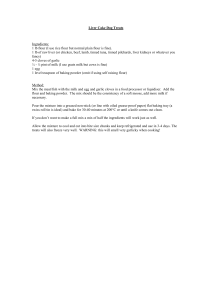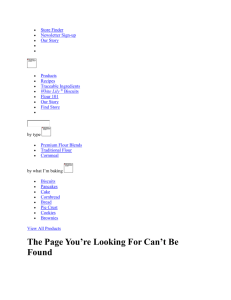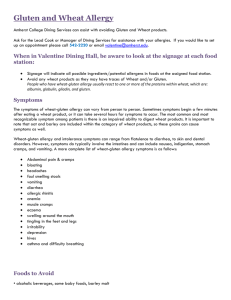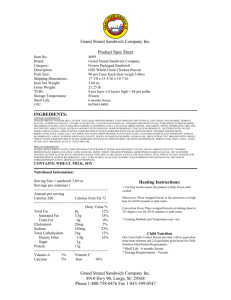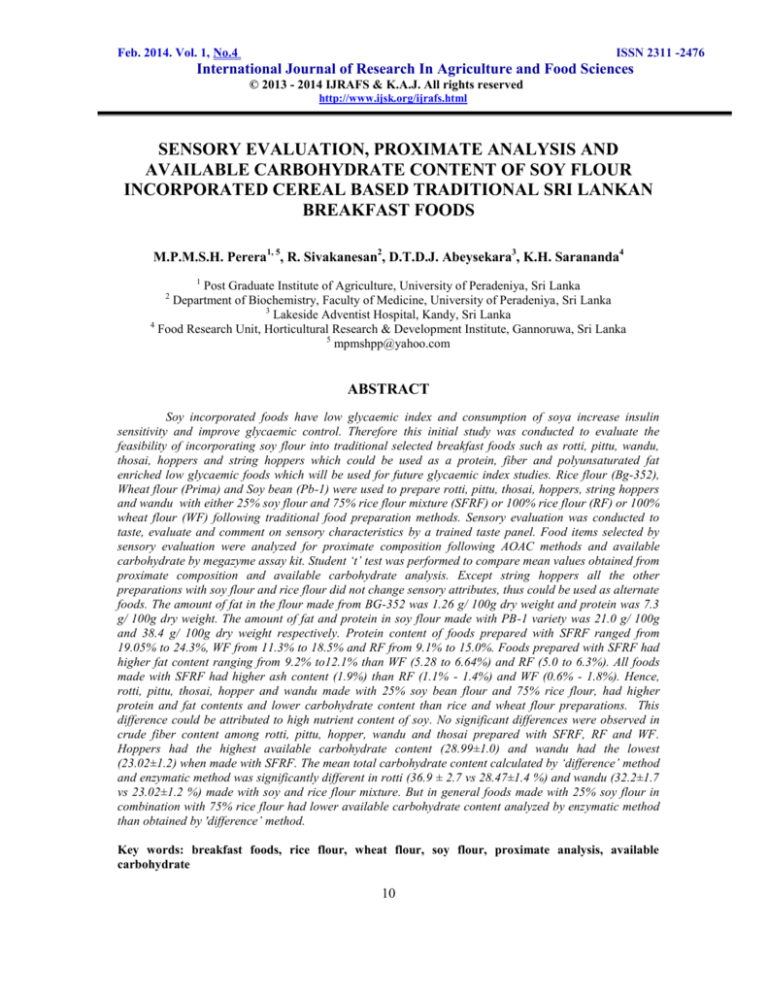
Feb. 2014. Vol. 1, No.4
ISSN 2311 -2476
International Journal of Research In Agriculture and Food Sciences
© 2013 - 2014 IJRAFS & K.A.J. All rights reserved
http://www.ijsk.org/ijrafs.html
SENSORY EVALUATION, PROXIMATE ANALYSIS AND
AVAILABLE CARBOHYDRATE CONTENT OF SOY FLOUR
INCORPORATED CEREAL BASED TRADITIONAL SRI LANKAN
BREAKFAST FOODS
M.P.M.S.H. Perera1, 5, R. Sivakanesan2, D.T.D.J. Abeysekara3, K.H. Sarananda4
1
Post Graduate Institute of Agriculture, University of Peradeniya, Sri Lanka
Department of Biochemistry, Faculty of Medicine, University of Peradeniya, Sri Lanka
3
Lakeside Adventist Hospital, Kandy, Sri Lanka
4
Food Research Unit, Horticultural Research & Development Institute, Gannoruwa, Sri Lanka
5
mpmshpp@yahoo.com
2
ABSTRACT
Soy incorporated foods have low glycaemic index and consumption of soya increase insulin
sensitivity and improve glycaemic control. Therefore this initial study was conducted to evaluate the
feasibility of incorporating soy flour into traditional selected breakfast foods such as rotti, pittu, wandu,
thosai, hoppers and string hoppers which could be used as a protein, fiber and polyunsaturated fat
enriched low glycaemic foods which will be used for future glycaemic index studies. Rice flour (Bg-352),
Wheat flour (Prima) and Soy bean (Pb-1) were used to prepare rotti, pittu, thosai, hoppers, string hoppers
and wandu with either 25% soy flour and 75% rice flour mixture (SFRF) or 100% rice flour (RF) or 100%
wheat flour (WF) following traditional food preparation methods. Sensory evaluation was conducted to
taste, evaluate and comment on sensory characteristics by a trained taste panel. Food items selected by
sensory evaluation were analyzed for proximate composition following AOAC methods and available
carbohydrate by megazyme assay kit. Student ‘t’ test was performed to compare mean values obtained from
proximate composition and available carbohydrate analysis. Except string hoppers all the other
preparations with soy flour and rice flour did not change sensory attributes, thus could be used as alternate
foods. The amount of fat in the flour made from BG-352 was 1.26 g/ 100g dry weight and protein was 7.3
g/ 100g dry weight. The amount of fat and protein in soy flour made with PB-1 variety was 21.0 g/ 100g
and 38.4 g/ 100g dry weight respectively. Protein content of foods prepared with SFRF ranged from
19.05% to 24.3%, WF from 11.3% to 18.5% and RF from 9.1% to 15.0%. Foods prepared with SFRF had
higher fat content ranging from 9.2% to12.1% than WF (5.28 to 6.64%) and RF (5.0 to 6.3%). All foods
made with SFRF had higher ash content (1.9%) than RF (1.1% - 1.4%) and WF (0.6% - 1.8%). Hence,
rotti, pittu, thosai, hopper and wandu made with 25% soy bean flour and 75% rice flour, had higher
protein and fat contents and lower carbohydrate content than rice and wheat flour preparations. This
difference could be attributed to high nutrient content of soy. No significant differences were observed in
crude fiber content among rotti, pittu, hopper, wandu and thosai prepared with SFRF, RF and WF.
Hoppers had the highest available carbohydrate content (28.99±1.0) and wandu had the lowest
(23.02±1.2) when made with SFRF. The mean total carbohydrate content calculated by ‘difference’ method
and enzymatic method was significantly different in rotti (36.9 ± 2.7 vs 28.47±1.4 %) and wandu (32.2±1.7
vs 23.02±1.2 %) made with soy and rice flour mixture. But in general foods made with 25% soy flour in
combination with 75% rice flour had lower available carbohydrate content analyzed by enzymatic method
than obtained by 'difference’ method.
Key words: breakfast foods, rice flour, wheat flour, soy flour, proximate analysis, available
carbohydrate
10
Feb. 2014. Vol. 1, No.4
ISSN 2311 -2476
International Journal of Research In Agriculture and Food Sciences
© 2013 - 2014 IJRAFS & K.A.J. All rights reserved
http://www.ijsk.org/ijrafs.html
and fair source of riboflavin (Food Composition
Tables for South East Asia, 1972). Rice protein
does not contain all the essential amino acids in
correct proportion for good health, and should be
combined with other source of protein. Rice is
specially deficient in essential amino acid lysine
and high in tryptophan and methionine. Rice flour
does not contain gluten so is suitable for people
requiring gluten free diet. Rice is a good source of
cellulose, which increases bulkiness in the gastro
intestinal tract (Charley, 1990).
1. INTRODUCTION
Diabetes mellitus is becoming a national
burden in Sri Lanka. The predicted estimate of prediabetes, diabetes and overall dysglycemia for the
year 2030 would be 13.11%, 13.9% and 26.2%,
respectively (Katulanda et al., 2008). Long-term
consumption of foods with high Glycaemic Index
invokes increased insulin demand and results in
insulin resistance, leading to Type II Diabetes and
thus eventually to cardiovascular diseases (BrandMiller et al., 2002). It has been proven that
management of diabetes at the initial stage and
prevention of future onset of diabetes and also
diabetes related complications could be easily and
effectively achieved by dietary management
(Sahabdazian et al., 2006; Committee CDACPGE
(2008).
Literature indicated that the glycaemic
index of soy incorporated foods are low and hence
have favorable effects on plasma lipid profile and
glycaemic control among Type II Diabetes mellitus.
Although glycaemic index values for soy and soy
milk are included in international table (Atkinson et
al., 2008) the glycaemic index values of typical soy
incorporated traditional Sri Lankan breakfast foods
are not incorporated. Studies on the importance and
effect of regular consumption of soy incorporated
cereal based breakfast foods in dietary management
among healthy and diabetic Sri Lankan individuals
under local conditions and lifestyle have not been
carried out up to now. The knowledge of the
glycaemic index of Sri Lankan soy incorporated
cereal based breakfast food preparations will be
vital with the increasing incidence of diabetes and
cardiovascular diseases, for manipulation of the
diets of individuals who are on diet control.
Therefore this initial study was conducted to
evaluate the feasibility of incorporating soy flour
into traditional selected breakfast foods such as
rotti, pittu, wandu, thosai, hoppers and string
hoppers which could be used as a protein, fiber and
polyunsaturated fat enriched low glycaemic foods
for diabetics since diabetes affects a significant
proportion of Sri Lankan population.
Soybeans (Glycine max) are native to
Asia, but today this plant is cultivated and
consumed worldwide. Soybean flour has many
important nutritious components, such as protein
(29.8 g %), including all essential amino acids, fats
(19.5 g %), carbohydrates (36.1 g %), fibers (3.8 g
%), water soluble vitamins particularly B1 (0.45 g
%), B2 (0.21 g %) and minerals particularly calcium
(189 mg %), phosphorus (540 mg %) and iron (7.5
mg %) (Food Composition Tables for South East
Asia, 1972). Glycaemic index of soy products are
low and are valuable foods to be included in a
diabetic diet. This has been attributed to many
factors (Lee et al, 2006). The isoflavones are
considered to be essential for the healthy
functioning of bowels, heart, kidney, liver, and
stomach (Perkins, 1997). The superiority of soy
protein regarding the capability to reduce blood
cholesterol compared to animal derived proteins
has also been documented (Desroches et al, 2004).
Soy protein exerts several anti-atherogenic effects
and it decreases LDL cholesterol significantly. Soy
has also been shown to increase insulin sensitivity
and to prevent the development of diabetes (Yang
et al, 2004). Dietary fiber, protein, and its
constituent isoflavones support its role in the
improvement of glycaemic control.
2. MATERIALS AND METHODS
2.1. Raw Materials
Raw rice (Bg-352) was obtained from Rice
Research and Development Institute, Bathalagoda.
Wheat flour (Prima, Ceylon Agro-Industries
Limited, Seeduwa, Sri Lanka) was purchased from
the local market. Soy bean (Pb-1) variety was
purchased from Pelwehera farm, Department of
Agriculture, Dambulla, Sri Lanka.
Rice (Oryza sativa) is the staple food
amongst all the ethnic groups in Sri Lanka and is a
basic ingredient for many breakfast foods. Rice is
approximately 75% carbohydrates, 10% protein, 1
to 2% fat, 10% moisture and 1 to 2% ash. Whole
grains are good source of iron, thiamine and niacin
11
Feb. 2014. Vol. 1, No.4
ISSN 2311 -2476
International Journal of Research In Agriculture and Food Sciences
© 2013 - 2014 IJRAFS & K.A.J. All rights reserved
http://www.ijsk.org/ijrafs.html
2.2. Preparation of Raw Materials
A mixture of flour, required amounts of
salt, boiled cooled water and grated coconut were
mixed thoroughly to a suitable consistency that did
not stick to the bowl. Then the dough was divided
into small balls, flattened to get a round shaped
rotti. Rotti were placed on a circular rotti pan and
heated on a mild blue-flame for 10 min, turning the
rotti upside down on the pan at 2 min intervals until
the outer surface was brown in colour.
Soy bean flour and rice flour were
prepared at the Food Research Unit, HORDI,
Department of Agriculture, Gannoruwa.
2.3. Soy Bean Flour
Soybean seeds were processed into flour
using the method of Wolf and Cowan (1981) to
ensure effective removal of most anti-nutritional
factors (Joseph, 1974). Soy bean seeds were sorted
washed and dehulled using a Hull Remover
(Reeves Reliance Electrical Company, Illinois,
USA). They were soaked overnight in cold water
and blanched at 1000C for 30 minutes, drained by
placing on a nylon sieve for 1 hour. Subsequently
they are dried in a Vertical Dryer at 500C for 5
hours (Phoenix TM -10, Japan) and milled using a
Ferrell-Ross Roller Mill (Ferrell-Ross Corporation,
Oklahoma, Okla, USA) and stored in a 350 gauge
polypropylene bag (Wolf and Cowan, 1981) at
room temperature.
2.7. Preparation of Pittu
Flour was steamed. Then required amounts
of grated coconut, salt and boiled cooled water
added and made it into putty. This mixture was then
broken into small pieces of approximately 2 mm to
5 mm diameter in size. This granular flour mix was
loosely packed and steamed in a pittu mould (PittuBambuwa) for about 10-12 minutes.
2.8. Preparation of Wandu
A mixture of flour, required amounts of
salt, coconut water, boiled cooled water and yeast
were mixed into a paste and kept for 4 hours for
fermentation. After 4 hours coconut milk and
caramel were added and the paste made to a smooth
batter. Then the batter was covered and kept for
about 30 minutes. A small amount (25 - 30 ml) of
batter was placed in the plate of the Wandu maker
and steamed for about 18 - 20 minutes.
2.4. Rice Flour
Paddy BG-352 was milled to 7% polishing
rate. Raw rice grains were sorted, washed, soaked
for 2 hours, drained, dried in a Vertical Dryer at
500C for 5½ hours (Phoenix TM -10, Japan),
followed by milling in a Micro Pulverizer ( Reeves
Reliance Electrical Company, Illinois, USA) and
stored at room temperature in a 350 gauge
polypropylene bag.
2.9. Preparation of Hoppers
A mixture of flour, required amounts of
salt, coconut water, boiled cooled water and yeast
were mixed into a paste and allowed to ferment for
6 hours. Then coconut milk was added and the
paste made to a smooth batter and kept for about 15
to 30 minutes. Then small amount of batter (25 - 30
ml) was placed in a non stick hopper pan and
cooked for about 2-3 minutes.
2.5. Food Preparation
Six starch based traditional breakfast foods
such as rotti, pittu, wandu, hoppers, string hoppers
and thosai were prepared at Food Research Unit,
Gannoruwa using either 25% soy flour and 75%
rice flour (SFRF) or 100% rice flour (RF) or 100%
wheat flour (WF) following traditional food
preparation methods and it was standardized, so
that the composition of the foods prepared on
different days did not vary. The ratio of soy flour
and red rice flour in SFRF amounts of scraped
coconut, coconut water, salt for each food
preparation and amount of black gram flour for
thosai preparation were selected by considering the
palatability accepted by a taste panel.
2.10. Preparation of Thosai
A mixture of flour, black gram flour
(10%), salt, coconut water and yeast was kept for
overnight fermentation. Then required amount of
coconut milk was added to make a smooth batter. A
small amount of the batter (25 to 35 ml) was spread
2.6. Preparation of Rotti
12
Feb. 2014. Vol. 1, No.4
ISSN 2311 -2476
International Journal of Research In Agriculture and Food Sciences
© 2013 - 2014 IJRAFS & K.A.J. All rights reserved
http://www.ijsk.org/ijrafs.html
to estimate consumer preference. Student ‘t’ test
was performed to compare the mean values of
nutrients obtained from proximate analysis. SPSS
statistical software version 14 (SPSS inc., Chicago
II., USA) was used to analyze data and
significances were determined at p< 0.05.
into a thin circle on a frying pan and heated on a
mild blue-flame for 10 min, turning the thosai
upside down on the pan at 2 min intervals until the
outer surface became golden brown in colour.
2.11. Preparation of String Hoppers
A mixture of flour, required amounts of
salt, boiled cooled water were mixed well to form a
ball and kept aside. Then the string hopper mould
was filled with the dough and squeezed onto cane
trays and was steamed for nearly 8-10 minutes.
3. RESULTS AND DISCUSSION
3.1. Proximate Composition of Dehulled Soy
Flour (PB-1) and Rice Flour (BG-352)
Moisture, fat, protein, ash and crude fiber
content of dehulled Soy flour (PB-1) and Rice flour
(BG-352) were determined by standard procedures
(AOAC, 1995) and carbohydrate content was
calculated following by ‘difference’ method. The
proximate composition is given in Table 3.1.
2.12. Sensory Evaluation
Sensory evaluation was conducted by 20
trained taste panelists from the Food Research Unit,
Gannoruwa. Each panelist received three samples
of six freshly prepared rotti, pittu, wandu, hoppers,
string hoppers and thosai to taste, evaluate and
comment on sensory characteristics. They were
asked to evaluate the flavor, texture, color and
overall acceptability based on 5 point hedonic
scale; like very much = 5, like moderately = 4,
neither like nor dislike = 3, dislike moderately = 2
and dislike very much = 1.
In the present study, the amount of fat in
rice flour made from BG-352 was 1.26 g/ 100g dry
weight and protein 7.3 g/ 100g dry weight. Palipana
et al. (1988) determined the proximate composition
of rice flour of 12 BG rice varieties grown in Sri
Lanka and reported the fat content to vary from
0.07 g/ 100g dry weight (BG-379) to 2.11 g/ 100g
dry weight (BG-94-1). They also observed a
minimum protein content of 6.29 g/ 100g dry
weight in BG-276-5 and maximum amount of 8.98
g/ 100g dry weight in BG-90-2. The fat and protein
values obtained for BG-352 variety were within the
range reported by Palipana et al. (1988).
2.13. Determination of Proximate Composition
and Available Carbohydrate Content
Food items were analyzed for proximate
composition by AOAC methods (1995) and
available carbohydrate by Megazyme assay kit
(Megazyme International Ireland, Ireland). The
available carbohydrate are those digested and
absorbed by the small intestine such as D-glucose,
D-fructose, sucrose, maltodextrins, D-glucose
component of lactose, and measured as D-glucose
plus D-fructose following enzymatic hydrolysis.
The calculated total carbohydrate content
of rice flour (BG-352) was 77.81 g/ 100g dry
weight. Sompong et al. (2011) analyzed three
unknown Sri Lankan rice varieties and found the
total carbohydrate content to be between 75.45 to
79.27 g/100g dry weight. Hence, BG-352 variety
had carbohydrate content similar to that reported by
Sompong et al. (2011) but was slightly lower than
the value of 80.1 g/ 100g dry weight given in Food
Composition Table for rice flour (Food
Composition Table for use in East Asia, 1972). The
mean available carbohydrate content of 53.65 g/
100g dry weight in BG-352 was lower than the
calculated total carbohydrate content.
2.14. Statistical Analysis
Non Parametric one - way ANOVA
(Analysis of variance) Kruscal Wallis test was
performed to calculate Mean Ranks and
Significance Levels of color, flavor, texture and
overall acceptability of cereal based traditional
breakfast foods prepared with SFRF, RF and WF
13
Feb. 2014. Vol. 1, No.4
ISSN 2311 -2476
International Journal of Research In Agriculture and Food Sciences
© 2013 - 2014 IJRAFS & K.A.J. All rights reserved
http://www.ijsk.org/ijrafs.html
Table.3.1. Proximate Composition of Dehulled Soy Flour (PB-1) and Rice Flour (BG-352)
Mean ± SD1 of constituent (%)
Flour
type
Moisture
Fat
Protein
Ash
Crude
fiber
Rice
10.73±1.3 1.26±0.3 7.30±0.7
1.70±0.2 1.20±0.03
Flour
Soy
5.20±0.7
21.0±1.89 38.43±1.6 1.15±0.3 0.08±0.01
Flour
1= Number of replicates = 3; 2 = Number of replicates = 6
The amount of fat in soy flour in variety
(PB-1) in our study was 21.0 g/ 100g dry weight,
which was similar to the value of 21.68 g/ 100g dry
weight reported by Srirwardhana et al. (2002) for
the same soy flour variety. Further the protein
content in soy flour in variety (PB-1) was 38.4 g/
100g dry weight which was slightly lower than the
value (41.34 g/ 100g dry weight) obtained by
Srirwardhana et al. (2002).
Carbohydrate
(by
difference)
Available
Carbohydrate 2
77.81
53.65
32.35
2.162
panel at Food Research Unit, Gannoruwa are
presented in table 3.2.
Sensory characteristics such as color,
flavor and texture of rotti prepared with SFRF, RF,
WF were at the same intensity, therefore no
significant differences were identified by the
panelists (p >0.05). SFRF (25% soy flour and 75%
red rice flour) mixture scored the highest value for
overall acceptability (16.90) for Rotti.
Carbohydrate composition of soy beans
varies according to the geographical locations
where the soybean is grown, harvesting conditions
and post-harvest processing. The total carbohydrate
content of soy flour in the present study was 32.35
g/ 100g dry weight, which was higher than the
value of 28.42 g/ 100g dry weight reported by
Siriwardhana et al. (2002). Dehulled soy beans
contain 35% carbohydrates with sucrose ranging
between 3-8%, raffinose between 0.1 - 1.5% and
stachyose between 1 to 6% and non starch
polysaccharides between 20 - 30%, the latter
consisting of 8% cellulose and the remaining as
peptic polysaccharides (Choct, 2010). Stachyose
and other raffinose family oligosaccharides are not
digested by humans, chickens, pigs, and other nonruminant animals (Obendorf et al., 2011). Myoung
et al. (2010) reported 4.6% of sucrose in dried
powdered soybean seeds when estimated by HPLC
method. The available carbohydrate content found
in this study was 2.16 g/ 100g dry weight.
Flavor, color and texture of pittu prepared
with RF had the highest mean rank. However the
mean rank of pittu prepared with SFRF, RF, WF
shows no significant difference among them
(p>0.05). At the same time pittu prepared with
100% red rice flour (RF) was identified as
significantly superior (p = 0.007) in their overall
acceptability compared with SFRF and WF.
Among the three thosai preparations,
color, flavor, texture of SFRF preparation was
identified as significantly superior (p<0.05) with an
overall acceptability of 19.30 (p=0.012).
Hopper made with SFRF had the highest
mean rank for flavor (17.55). Color and texture of
hopper made with RF was superior (18.10, 17.00
respectively). Hoppers made with SFRF and RF
were accepted as best food preparation (16.60) but
no significant difference was observed (p=0.551)
between them.
3.2. Sensory Evaluation
Among the 3 string hopper preparations
color, flavor, texture of WF preparation was
identified as significantly superior (p<0.05) than
others. String hoppers made using 25% soy flour
The result of sensory evaluation of rotti,
pittu, thosai, hoppers, string hoppers and wandu
prepared with SFRF, RF and WF by trained taste
14
Feb. 2014. Vol. 1, No.4
ISSN 2311 -2476
International Journal of Research In Agriculture and Food Sciences
© 2013 - 2014 IJRAFS & K.A.J. All rights reserved
http://www.ijsk.org/ijrafs.html
Table 3.2. Mean Ranks of Color, Flavor, Texture and Overall Acceptability of all Cereal Based Foods prepared
Name of the food
prepared
Rotti
SFRF
RF
WF
Flavor
Color
Texture
Overall
acceptability
P
17.15
17.15
12.20
0.253
14.55
18.30
13.65
0.299
16.10
16.95
13.45
0.516
16.90
16.50
13.10
0.393
P
12.50
17.10
16.90
0.365
12.15
19.40
14.95
0.132
11.20
18.25
17.05
0.126
9.45
20.90
16.15
0.007
P
16.10
16.10
14.30
0.846
16.25
15.25
15.00
0.933
16.40
17.55
12.55
0.278
15.05
17.40
14.05
0.613
P
17.55
16.15
12.80
0.380
15.15
18.10
13.25
0.389
15.30
17.00
14.20
0.742
16.60
16.60
13.30
0.551
P
10.05
16.50
19.95
0.015
9.50
16.90
20.10
0.012
10.80
15.35
20.35
0.033
8.80
17.15
20.55
0.033
P
18.25
10.25
18.00
0.003
20.70
8.70
17.10
0.041
19.65
16.60
16.25
0.041
19.30
9.60
17.60
0.012
Pittu
SFRF
RF
WF
Wandu
SFRF
RF
WF
Hoppers
SFRF
RF
WF
String Hoppers
SFRF
RF
WF
Thosai
SFRF
RF
WF
and 75% red rice flour was identified as
significantly inferior (overall acceptability of 8.80,
P = 0.003) by the taste panel.
well as overall acceptability among the three wandu
preparations.
3.2. Proximate Composition of Rotti, Pittu,
Thosai, Hoppers and Wandu
Flavor characteristic of wandu made with
SFRF and RF was at the same level (16.10). SFRF
preparation was identified as superior (16.25) in its
color and RF was identified as superior (17.55) in
its texture. RF preparations were identified as the
best food among the three preparations (overall
acceptability of 17.40). No significant differences
were identified in their sensory characteristics as
Proximate composition of rotti, pittu,
thosai, hoppers and wandu prepared with SFRF, RF
and WF are given in Table 3.3. Total carbohydrate
content was calculated by ‘difference’ method.
15
Feb. 2014. Vol. 1, No.4
ISSN 2311 -2476
International Journal of Research In Agriculture and Food Sciences
© 2013 - 2014 IJRAFS & K.A.J. All rights reserved
http://www.ijsk.org/ijrafs.html
Table.3.3. Proximate Composition of Rotti, Pittu, Thosai, Wandu and Hoppers
Mean ±SD* of Constituent (%)
Food item
Rotti
SFRF
RF
Moisture
31.7±1.65a
b
Fat
9.5±0.72a,b
a
Pittu
Thosai
Hoppers
Wandu
Rotti
37.5±1.41
33.5±1.70a
33.62±1.10a
35.1±0.27b
32.5±1.36a
Pittu
37.4±1.69b,d 5.0±0.20a
a
9.2±0.32
12.1±0.15b
10.2±0.30a
11.6±0.01a,b
5.3±0.48a
a
Protein
Ash
Crude
fiber
Carbohydrate
(by
difference)
19.6±1.17a,c,d
1.9±0.14a
0.2±0.02a
36.9
a,c,d
21.7±1.40
24.3±1.02b
21.0±0.32a,c,d
19.1±0.68d
10.3±0.34a
a
1.9±0.06
1.9±0.06a
1. 9±0.01a
1.9±0.03 a
1.4±0.11a
a
0.2±0.02
0.2±0.02a
0.1±0.02a
0.1±0.02a
0.4±0.02a
29.3
27.8
33.2
32.2
49.9
9.1±0.63a,b
1.1±0.11a
0.3±0.02a
46.8
c
a
1.3±0.09
1.2±0.07 a
1.4±0.07 a
a
0.3±0.02
0.2±0.02a
0.2±0.02a
45.5
49.1
46.0
38.9
Thosai
Hoppers
Wandu
31.4±1.26
34.3±0.17b
37.6±0.64d
6.3±0.50
5.9±0.04a
5.2±0.28 a
15.0±1.40
9.3±1.07a
9.6±0.44a
Rotti
36.1±0.84a,c
5.9±0.36a
16.7±0.96a
1.8±0.11a
0.3±0.02a
a,c
a
a
a
a
Pittu
34.8±2.53
5.5±0.30
15.0±1.45
1.8±0.06
0.2±0.02
42.4
Thosai
32.5±1.92a
6.6±0.20a
18.5±1.47a
0.6±0.03b 0.3±0.02a
41.3
a,c
b
b
b
a
Hoppers 35.9±1.10
5.3±0.38
12.1±0.89
0.6±0.02
0.2±0.02
45.9
Wandu
37.9±0.26b,c 5.6±0.27 a
11.3±0.22 b
1.2±0.02c 0.2±0.02a
43.8
* Number of replicates = 3
Comparison was made among rotti, pittu, thosai , hoppers and wandu for each flour type
Treatment means of food items prepared for a given composition in a column having common superscript
are not significantly different by ‘t’ test (p> 0.05)
SFRF = 25% soy flour, 75% rice flour, RF = 100% rice flour, WF = 100% wheat flour
WF
lowest moisture content and wandu had the highest
(37.7%). No significant difference was observed
among foods made with WF except between thosai
and wandu (32.5%, 37.9%, p=0.0429).
3.4. Moisture
Moisture content of foods prepared with
SFRF ranged from 31.7% – 37.5%, RF ranged from
31.4% – 37.6% and WF 32.5% -37.9%. Rotti had
lowest moisture (31.7%) content while pittu had the
highest (37.5%). Significant difference was
observed between pittu and rotti (37.5%, 31.7%,
p=0.012), pittu and thosai (37.5%, 33.5%, p=0.037)
and pittu and hoppers (37.5%, 33.6%, p=0.022).
Thosai made with RF (31.4%) had the lowest
moisture content and it was highest in wandu
(37.55%). Significant difference was observed
between foods made with RF such as rotti and pittu
(32.5%, 37.4%, p=0.019), rotti and wandu (32.5%,
37.6%, p=0.012), pittu and thosai (37.4%, 31.4%,
p=0.009), wandu and thosai (31.4%, 37.6%,
p=0.005) and wandu and hoppers (34.3%, 37.6%,
p=0.008). Thosai made with WF (32.59%) had
3.5. Protein
Protein content of foods prepared with
SFRF ranged from 19.05% - 24.3%, WF 11.3% 18.5% and RF ranged from 9.1% - 15.0%. Soy
flour is rich in protein (Table 3.1) therefore foods
made with SFRF had the highest protein content
compared with foods made with WF and RF.
Cereals are deficient in essential amino acid lysine
and high in tryptophan and methionine but soya is
deficient in methionine and rich in lysine (Charley,
1990). Therefore foods made with SFRF will
provide better protein quality to the consumers.
Foods made with WF had higher protein content
16
Feb. 2014. Vol. 1, No.4
ISSN 2311 -2476
International Journal of Research In Agriculture and Food Sciences
© 2013 - 2014 IJRAFS & K.A.J. All rights reserved
http://www.ijsk.org/ijrafs.html
compared to RF since wheat flour contain more
protein (8.6%) (Food Composition table for use in
South Asia, 1972) than BG-352 rice flour (7.3%,
Table 3.1). Rotti had lowest protein (19.05%)
content and thosai had the highest (24.3%).
Significant difference was observed between thosai
and rotti (24.3%, 19.6%, p=0.006), thosai and
hoppers (24.3%, 21.0%, p=0.002) and thosai and
wandu (24.3%, 19.5%, p=0.004). Pittu made with
RF had lowest protein content (9.1%) and thosai
had the highest (15.0%). Significant differece was
observed between thosai and rotti (15.0%, 10.3%,
p=0.02), thosai and pittu (15.08%, 9.18%,
p=0.008), thosai and hoppers (15.08%, 9.3%,
p=0.005) and thosai and wandu (15.08%, 9.6%,
p=0.014). Similarly thosai made with WF had the
highest protein (18.5%) and wandu has the lowest
(11.3%). Significant difference was observed
between rotti and hoppers (16.75%, 12.05%,
p=0.003), rotti and wandu (16.75%, 11.24%,
p=0.007), pittu and thosai (18.5%, 15.08%,
p=0.045), pittu and hoppers (15.68%, 12.05%,
p=0.047), pittu and wandu (15.085, 11.24%,
p=0.041), thosai and hoppers (18.5%, 12.05%,
p=0.005) and thosai and wandu (18.5%, 11.24%,
p=0.012). Protein content of thosai was the highest
among foods prepared with either SFRF or WF or
RF because of the added black gram (26.8%) which
is rich in protein (Hettiarachchi et al., 1981).
All foods made with SFRF had higher ash
content (1.9%) than RF (1.1% - 1.4%) and WF
(0.6% - 1.8%). Foods made with RF and SFRF did
not differ in their ash content. Rotti and Pittu made
with WF had equal amount of ash (1.8%) and it was
higher than wandu (1.2%). Thosai and hoppers
made with WF had the lowest ash content (0.6%).
Significant difference was observed between rotti
and thosai (1.8%, 0.6%, p=0.001), rotti and hoppers
(1.8%, 0.6%, p=0.001), rotti and wandu (1.8%,
1.2%, p=0.005), pittu and thosai (1.8%, 0.6%,
p=0.001), pittu and hoppers (1.8%, 0.6%, p=0.001)
and pittu and wandu (1.8%, 1.2%, p=0.005).
3.8. Fiber
No significant difference was observed in
crude fiber content among rotti, pittu, hopper,
wandu and thosai prepared with SFRF, RF and WF.
3.9. Total Carbohydrate
Total carbohydrate content was calculated
by ‘difference’ method and it was low in rotti, pittu
and thosai made with SFRF (36.9%, 29.3%, 27.7%
respectively) compared to RF (49.9%, 46.8%,
45.5% respectively) and WF (38.9%, 42.4%, 41.3%
respectively) because soy flour contain 32.35 % of
carbohydrate, rice flour has 77.81% (Table 3.1) and
white wheat flour contains 77% (Food Composition
Tables for South East Asia, 1972).
3.6. Fat
Foods prepared with SFRF had higher fat
content ranging from 12.1% – 9.2% than WF
(6.64% - 5.28%) and RF (6.3% - 5.0%). Significant
difference was observed between thosai and pittu
(12.1%, 9.2%, p=0.022) and thosai and hopper
(12.1%, 10.2%, p=0.034) with SFRF. Highest fat
content observed in thosai (6.3%) and lowest
observed in pittu (5.0%) made with RF. No
significant difference observed in foods made with
RF. Thosai made with WF had higher fat content
(6.64%) and the lowest was hoppers (5.28%) and
the difference was significant. Partial replacement
of WF and RF used to prepare breakfast food with
soy flour thus increases the fat content appreciably.
Since soy contains 54% linolenic acid and 7%
linoleic acid, which are essential fatty acids (Earl et
al., 2005), the replacement with soy flour may
prove beneficial.
3.10 Available Carbohydrate Content of Rotti,
Pittu, Thosai, Hoppers and Wandu made
from SFRF
The available carbohydrate content of rotti,
pittu, thosai, hoppers and wandu made with SFRF
are given in table 3.4. The mean total carbohydrate
content calculated by ‘difference’ method and
enzymatic method was significantly (p < 0.05)
different in rotti (36.9 ± 2.7 vs 28.47±1.4 %) and
wandu (32.2±1.7 vs 23.02±1.2 %) made with soy
and rice flour mixture.
3.7. Ash
17
Feb. 2014. Vol. 1, No.4
ISSN 2311 -2476
International Journal of Research In Agriculture and Food Sciences
© 2013 - 2014 IJRAFS & K.A.J. All rights reserved
http://www.ijsk.org/ijrafs.html
Table 3.4. Comparison between total carbohydrate content and available carbohydrate content of rotti, pittu,
thosai, hoppers and wandu made from SFRF
Name of
the Food
Total CHO by
ACH
‘Difference,
(g/100g)
(g/100g) (X%)1
(Y%)2
Rotti
36.9 ± 2.7
28.47±1.4
Pittu
29.3±2.0
27.98±1.6
Thosai
27.8±2.5
25.48±0.9
Hoppers
33.6±2,5
28.99±1.0
Wandu
32.2±1.7
23.02±1.2
1= Mean of 3 replicates; 2= Mean of 6 replicates
Difference in mean
carbohydrate content
(X – Y%)
8.43
1.32
2.20
3.17
9.18
P value by ‘t’
test
0.028
0.309
0.224
0.085
0.004
obesity. American Journal of Clinical Nutrition, 76,
281s-285s.
4. CONCLUSION
Except string hoppers all the other preparations
with soy flour and rice flour did not change sensory
attributes, thus could be used as alternate foods. It
was observed that 25% of soy bean flour in
combination with 75% rice flour was significantly
high in protein and fat but low in carbohydrate in
rotti, pittu, thosai, hopper and wandu compared to
rice and wheat flour preparations because of the
high fat and protein content of soy flour. Foods
made with 25% soy flour in combination with 75%
rice flour had lower available carbohydrate content
analyzed by enzymatic method than obtained by
‘difference’ method.
3.
Charley, H. (1990). Food Science. Pp.133-145. John
Wiley & Sons., New York,USA.
4.
Choct, M., Dersjant-Li,Y., McLeish, J. and Peisker,
M. (2010). Soy Oligosaccharides and Soluble Nonstarch polysaccharides: A review of Digestion,
Nutritive and Anti-nutritive Effects in Pigs and
Poultry. Asian - Australasian Journal of Animal
Sciences, 23 (10), 1386-1398.
5.
Committee
CDACPGE.
Canadian
Diabetes
Association. (2003). Clinical Practice Guidelines for
the Prevention and Management of Diabetes in
Canada. Canadian Journal of Diabetes, 27, S1S152.
5. ACKNOWLEDGEMENT
6.
The great assistant provided by the staff of
Food Research Unit, HORDI, Department of
Agriculture, Gannoruwa, Institute of Post Harvest
Technology, Jayanthi Mawatha, Anuradhapuraya
and Rice Research and Development Institute,
Bathalagoda are highly acknowledged for their
support, and commitment to make this research
study a success.
Desroches, S., Mauger, J.F.,Ausman, L.M.,
Lichtenstein, A.H. and Lamarche, B.(2004). Soy
protein favorably affects LDL size independently of
Isoflavons in hypercholesterolemic men and women.
Journal of Nutrition, 134(3), 574-579.
7.
Earl, G. Hammond., Lawrence, A. Johnson.,
Caiping Su, Tong Wang, and Pamela J. White.
(2005). Bailey’s industrial Oil and Fat Products.
(Edited by Fereidoon Shahidi). pp. 573- 653. John
Wieley & Sons, Inc.
6. REFERENCES
8.
Food Composition Tables for South Asia. (1972).
FAO, Manila, Philippine.
9.
Hettiarachchi, N.S. and Sri Kantha, S. S. (1981).
Trypsin Inhibitor and Phytoheamagglutinine content
in the seeds of six legumes commonly used in Sri
Lanka. Journal of the National Science Council of
Sri Lanka, 9 (2) 269-272.
1.
2.
Atkinson, F.S., Foster-Powell, K. and Brand-Miller,
J.C. (2008). International table of glycaemic index
and glycaemic load values. Diabetes Care, 31,
2281-2283.
Brand-Miller, J. C., Holt, S. H. A., Pawlak, D. B.
and McMillan, J. (2002). Glycaemic Index and
18
Feb. 2014. Vol. 1, No.4
ISSN 2311 -2476
International Journal of Research In Agriculture and Food Sciences
© 2013 - 2014 IJRAFS & K.A.J. All rights reserved
http://www.ijsk.org/ijrafs.html
10. Joseph J. Rackis. (1974). Biological and
physiological factors in soy beans. Journal of the
American Oil Chemists' Society, 51 (1), 161A-174A.
20. Wolf, W.J. and Cowan, J.C. (1981). Soybeans as a
food source. P: 46-77. CRC Press, Peoria , Illinois,
USA.
11. Katulanda, P., Constantine, G. R., Mahesh, J. G.,
Sheriff, R., Senevirathna, R. D., Wijerathne, S.,
Wijesuriya, M., McCarthy, M. I., Adler, A. I., and
Matthews, D. R. (2008). Prevalence and projection
of diabetes and pre-diabetes in adults in Sri lanka –
Sri Lanka Diabetes, Cardiovascular Study. Diabetes
Medicine, 9, 1062-1069.
21. Yang, G., Shu, X. O., Jin, F., Elasy, T., Li, H.L., Li,
Q., Huang, F., Gao, Y.T. and Zheng, W., (2004).
Soy food consumption and risk of glycosuria: a
cross-sectional study within the Shanghai Women’s
Health Study. European Journal of Clinical
Nutrition, 58, 615-620.
12. Lee, S. H., Park, H.J., Chun, H. K., Cho, S.Y., Cho,
S. M. and Hyun, S. L. (2006). Dietary phytic acid
lowers the blood glucose level in diabetic KK mice.
Nutrition Research, 26, 474-9.
13. Myoung-Gun Choung. (2010). Determination of
Sucrose Content in Soybean using Near-Infrared
Reflectance Spectroscopy. Journal of the Korean
Society for Applied Biological Chemistry, 53(4),
478-484.
14. Obendorf, Ralph, l. and Kosina, Suzanne, M.
(2011). Soluble Carbohydrates in Soybeans,
Soybean-Biochemistry, Chemistry and Physiology,
Prof. Tzi-Bun Ng (Ed.), ISBN: 978-539-307-219-7.
15. Palipane,
K.B.,
Swarnasiri,
D.P.C.
and
Thilakarathna,
B.M.K.S.
(1988).
Tropical
Postharvest Technologist. pp. 31-38. Rice
Processing Research & Development Centre,
Anuradhapuraya, Sri Lanka.
16. Perkins, E.G. (1997). Composition of soybeans and
soybeans products. Practical handbook of soybean
processing and utilization. (3rd ed.) pp. 9-28.AOAC
Press, USA.
17. Sahabdazian H. B., Amani R., Siadatan J., lathif M.,
Ahamadzadeh A., and Haghihizadeh M. (2006).
Beneficial effects of soy protein isoflavons on lipids
and blood glucose concentrations in type 2 diabetic
subjects.
Jundishpur
Journal
of
Natural
Pharmaceutical Products, 1, 48-52.
18. Sampong, R., Siebenhandl-Ehn, S., LinsbergerMartin,
G.
and
Berghofer,
E.
(2011).
Physicochemical and antioxidative properties of red
and black rice varieties fron Thailand, China and Sri
Lanka. Food Chemistry, 124,132-140.
19. Siriwardana, T.D.W., Bamunuarachchi, A., and
Perera, P.A.J. (2002). Cereal and soy based
supplementary foods manufactured by extrusion and
roller drying methodologies. Annals of the Sri
Lanka Department of Agriculture. 4, 375-384.
19


